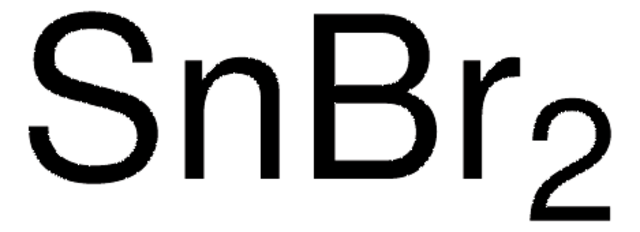452335
Tin(II) chloride
anhydrous, powder, ≥99.99% trace metals basis
Synonym(s):
Stannous chloride
About This Item
Recommended Products
grade
anhydrous
Quality Level
vapor pressure
33 hPa (~429 °C)
Assay
≥99.99% trace metals basis
form
powder
reaction suitability
reagent type: catalyst
core: tin
pH
2.18 (20 °C)
bp
606 °C
652 °C (lit.)
mp
246 °C (lit.)
solubility
water: soluble 1780 g/L at 10 °C
SMILES string
Cl[SnH2]Cl
InChI
1S/2ClH.Sn/h2*1H;/q;;+2/p-2
InChI key
AXZWODMDQAVCJE-UHFFFAOYSA-L
Looking for similar products? Visit Product Comparison Guide
Related Categories
General description
Application
accessory
Signal Word
Danger
Hazard Statements
Precautionary Statements
Hazard Classifications
Acute Tox. 4 Inhalation - Acute Tox. 4 Oral - Aquatic Chronic 3 - Eye Dam. 1 - Met. Corr. 1 - Skin Corr. 1B - Skin Sens. 1 - STOT RE 2 Oral - STOT SE 3
Target Organs
Cardio-vascular system, Respiratory system
Storage Class Code
8B - Non-combustible corrosive hazardous materials
WGK
WGK 3
Flash Point(F)
Not applicable
Flash Point(C)
Not applicable
Personal Protective Equipment
Choose from one of the most recent versions:
Certificates of Analysis (COA)
Don't see the Right Version?
If you require a particular version, you can look up a specific certificate by the Lot or Batch number.
Already Own This Product?
Find documentation for the products that you have recently purchased in the Document Library.
Customers Also Viewed
Articles
Silylethyne substitution offers an opportunity to tune solubility for application-specific needs and self-assembly for electronic performance and has yielded semiconductors with excellent device performance.
Silylethyne substitution offers an opportunity to tune solubility for application-specific needs and self-assembly for electronic performance and has yielded semiconductors with excellent device performance.
Silylethyne substitution offers an opportunity to tune solubility for application-specific needs and self-assembly for electronic performance and has yielded semiconductors with excellent device performance.
Silylethyne substitution offers an opportunity to tune solubility for application-specific needs and self-assembly for electronic performance and has yielded semiconductors with excellent device performance.
Our team of scientists has experience in all areas of research including Life Science, Material Science, Chemical Synthesis, Chromatography, Analytical and many others.
Contact Technical Service







